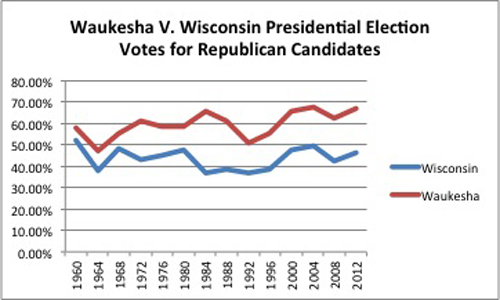A Way Out
A bipartisan political conversation won’t begin anytime soon, according to Michael Wagner, an expert on partisan polarization in the American electorate in UW-Madison’s School of Journalism and Mass Communication. Nationally, “we have been trending toward more polarization for a long time,” he says.
Waukesha’s voting patterns confirm this trend on a local level. Since the ‘60s, the county has grown more divorced from the opinions of the rest of the state. In 1960, almost 6 percent more people in Waukesha voted for the Republican presidential candidate than the rest of Wisconsin. By 2000, that number tripled to 18 percent, climbing to 21 percent in 2012.

Waukesha’s future is difficult to predict, but nationally, the political parties cannot remain at status quo for long. According to the U.S. Census Bureau, just this year, more than 50 percent of all children born belonged to an ethnic minority, a demographic not generally allied with the Republican Party. The parties will have to shift to curry favor to a reshaped electorate or risk insignificance.
In time, polarization may decrease as demographics shift, but the future remains uncertain.
Yet, Pas feels like he is on the right track. While sipping his apple cider, no longer hot, he appears resigned. He wishes things were different, but Waukesha is his home, and he plans to weather the political climate for better or worse.
“A lot of the effort is flying the flag. In a county as one-sided as this one, a lot of what you can do is just being there.”
Related Posts:
